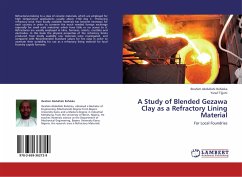Refractories belong to a class of ceramic materials, which are employed for high temperature applications usually above 1100 deg C . Producing refractory brick from locally available materials has become necessary for each country in order to conserve the much needed foreign exchange especially for small scale industries which have little or no access to it. Refractories are usually employed in kilns, furnaces, retorts, crucibles and electrodes. In this book the physical properties of the refractory bricks produced from locally available raw materials were investigated, and compared with Recommended Standard values for fire clays in order to ascertain their suitability for use as a refractory lining material for local foundry cupola furnaces.
Bitte wählen Sie Ihr Anliegen aus.
Rechnungen
Retourenschein anfordern
Bestellstatus
Storno

